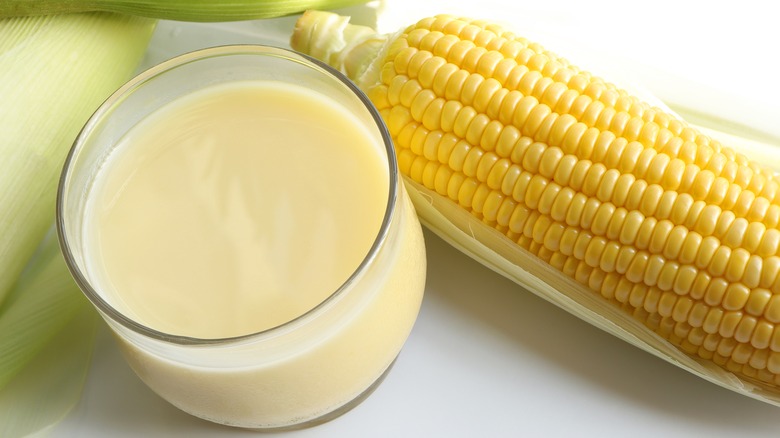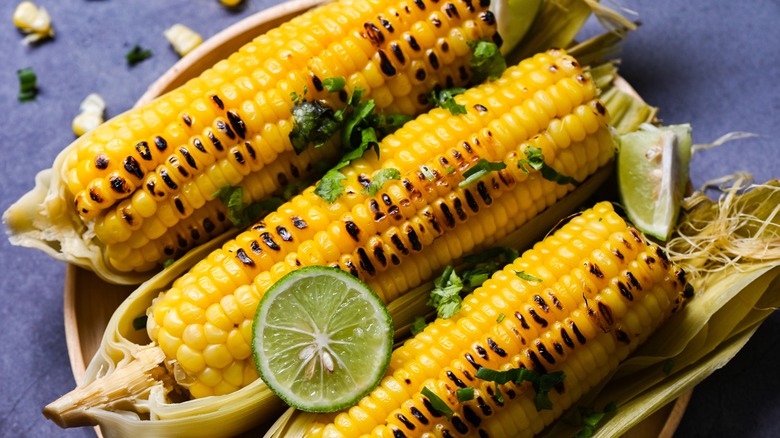Who Needs Butter When You Can Boil Your Corn In Coconut Milk?
How do you like your corn? Grilled? Popped? Steamed? Creamed? There are endless ways to prepare those plump golden kernels, but one method that's easy, efficient, and too often overlooked is boiled corn on the cob.
Boiling corn doesn't require much in terms of cooking chops. You simply bring a large pot of water to a boil, add the corn, cover the pot, and let the whole thing cook for three to five minutes. When the corn is pulled from the water, the kernels should glow a fluorescent yellow and taste sugary sweet.
However, this is beginner-level boiled corn. If you want to elevate your cobs to new heights, then you need to experiment with different cooking liquids and seasonings. And forget about your basic butter-water combination; the best way to add a touch of decadence to your standard corn on the cob is to boil them in rich and creamy coconut milk. By submerging the corn in an aromatic coconut-based broth, you can infuse those kernels with the perfect kiss of nutty sweetness that will bring this side dish to the main stage of your meal.
Creating the ultimate coconut corn boil
When it comes to boiling your corn in coconut milk, you will want to focus most of your attention on crafting a well-balanced stock. To create your broth, first start with a can of either regular or lite coconut milk. If these are unavailable, coconut cream is another option, but, due to its higher fat content, the broth may require the addition of extra liquid, like water or chicken broth. Remember, the goal is to have the corn completely submerged so it can cook fully and evenly.
Next, you're going to add in your seasonings. This step is largely determined by your personal taste preferences, heat tolerance, etc. However, since the tradition of cooking corn in coconut milk has its roots in Caribbean, Guyanese, and African cuisines, many recipes call for big flavors, like scotch bonnet peppers, chiles, garlic, scallions, ginger, or fresh herbs.
After adding and dissolving your seasonings in your cooking liquid, it's time to drop in the corn and bring the whole mixture to a boil. But unlike ordinary boiled corn, you're not going to remove the cobs so quickly. Instead, you're going to let the corn sit in the coconut broth bath until the liquid reduces down to a rich and decadent sauce, which you can spoon over your corn before serving. And this is what makes the dish so darn special.
Other ways to elevate your corn on the cob
Corn on the cob isn't just for summertime cookouts and picnics in the park. You can enjoy corn all year round, which is a wonderful thing because there are so many different ways to prepare it!
The classic method is grilling, which adds a dimension of char that complements the corn's natural sweetness. If you choose to grill the corn in the husks, just remember to soak the whole package in water for at least 15 minutes before grilling. Otherwise, the husks might ignite. Another technique is to slow-cook your corn. Quickly rub each ear of corn with butter (and/or other seasonings) and wrap — individually — in aluminum foil, before adding to the slow cooker with around a ¼ cup of water and cooking for three to four hours.
Baked corn on the cob is something you don't see every day, but throwing your corn in the oven is a perfectly delectable way to prepare it, too. Slather the outside of the corn with some butter, lime, and chile, and bake for around 30 minutes. And for those of you who like your veggies with a side of meat, you can always wrap your corn with bacon and throw it on the grill (just remember to also wrap the whole thing in aluminum foil, or else your bacon will burn before your corn is fully cooked). With so many options to choose from, you'll never be relegated to boring corn again!


